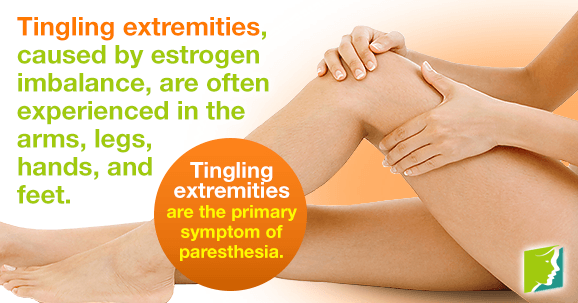The effects of aging and menopause change your body inside and out. As the skin loses its elasticity, some women may notice a duller color, dryness, numbness, and tingling sensations. While not life-threatening, this symptom can be bothersome and irritating. If tingling extremities are making you want to step out of your own skin, don't worry - there are some options for relieving your discomfort.
What Causes Tingling Extremities?
One of estrogen's many jobs is maintaining your skin's vitality and suppleness. Estrogen receptors located in the skin enable this hormone to direct more blood flow to the skin and stimulate the production of collagen, the skin's main structural protein. However, during menopause, your estrogen levels may be in flux, leading to thinner skin. This makes it more susceptible to cracking and wrinkling. Weak skin also becomes more sensitive, giving way to tingling, burning, or numbing sensations.
Do Tingling Extremities Indicate a Real Medical Condition?
In some cases, yes, tingling can indicate a real medical condition. Tingling extremities are the primary symptom of a condition called paresthesia. This condition, which is not uncommon in menopausal women, is characterized by a variety of tactile experiences. You may feel like your arms or legs are just recovering from “falling asleep” or like you're being pricked by tiny pins. Feelings such as burning, tingling, and loss of sensation altogether are also common in people who experience paresthesia.
Although it is most often experienced in the arms, legs, hands, and feet, there have been reports of paresthesia in various other body parts, such as the face and neck.
How Can I Treat Tingling Extremities?
Unfortunately, there is no cure for tingling extremities, but there are simple lifestyle changes you can make to reduce the discomfort they cause, such as:
Regular exercise. This will help improve blood flow to your skin. It's important to keep moving throughout the day. This advice is especially important for women who have a sedentary lifestyle and office workers.
Lifestyle changes. Avoid habits that interfere with collagen production, such as smoking.
Skin care. Make sure to moisturize with lotion or skin cream every day.
More Information about Tingling Extremities during Menopause
Paresthesia is characterized by episodic sensations of prickly or burning skin, so if you find that this is a constant or chronic problem, you should contact a doctor. Chronic tingling can be a sign of a more serious condition, such as carpal tunnel syndrome.
Read for more information on treatments for tingling extremities.
Sources
- Hutchinson, Susan M.D. "The Stages of a Woman's Life: Menstruation, Pregnancy, Nursing, Perimenopause, Menopause". November 2007.
- Love, Susan M.D. Menopause and Hormone Book. New York: Three Rivers Press, 2003.
- BMJ Group. "Menopause: What is it?" Patient Leaflet. 2007




